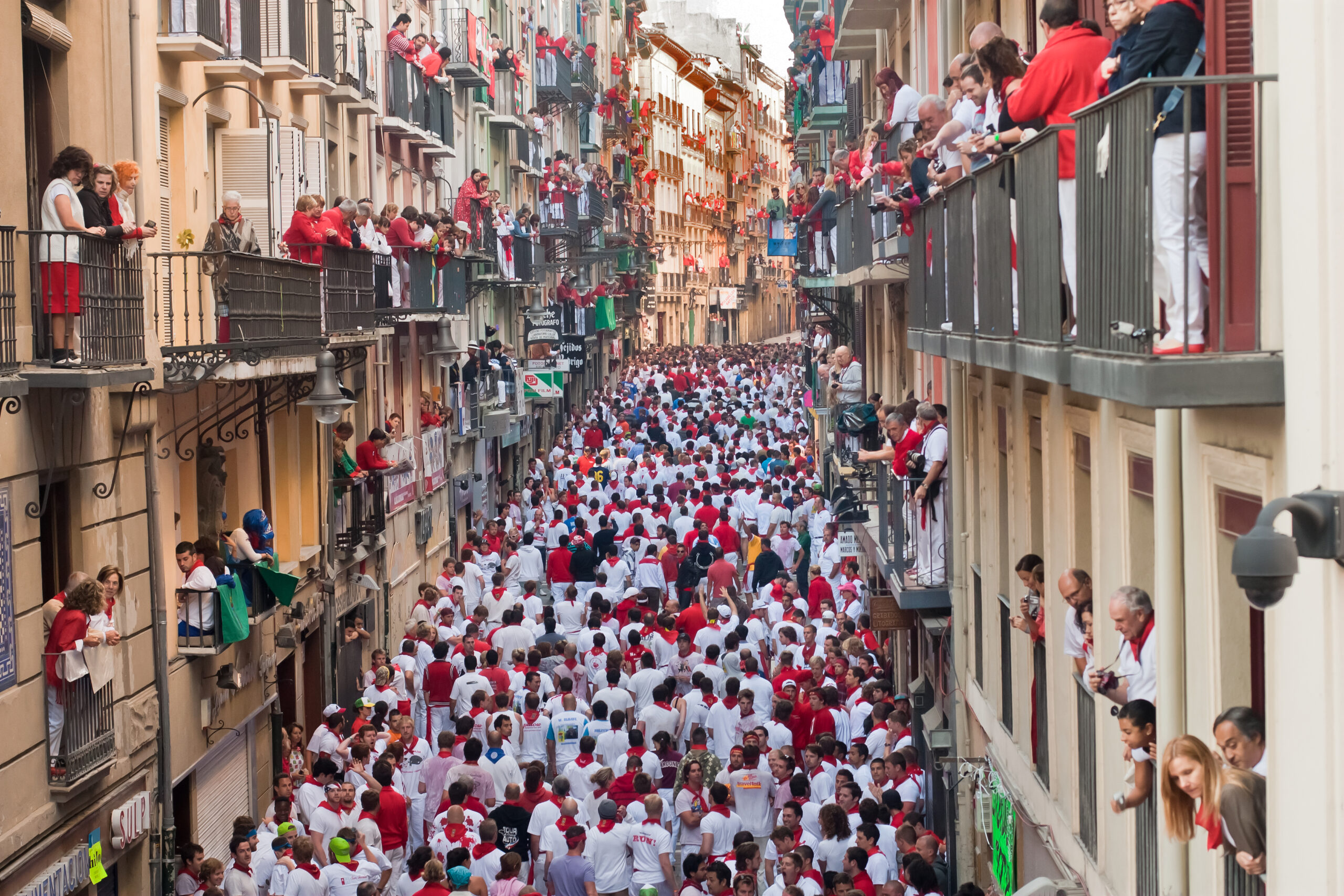On the border with France in the north of Spain lies the old kingdom of Navarre, one of the smallest autonomous communities in the country. Its history was shaped by the region’s close border location.
Navarre is home to numerous medieval towns worth visiting, such as the 900-year-old town of Estella with its historic town center and the Palace of the Kings of Navarre from the 12th century, the only Romanesque secular building still standing in the province today. Also worth seeing are the medieval towns of Tudela, Olite with the former royal palace Palacio Real de Olite, the town of Artajona, whose old town center has been classified as a cultural asset, and Roncesvalles, an important stop on the famous Way of St. James.
The silhouette of the crenellated castle of Javier rises some 500 meters above sea level. The town also boasts the parish church of La Anunciación, which houses the baptismal font of Francisco de Javier. Los Argos is home to a richly decorated church dating from the 12th to 18th centuries and a French aqueduct that also serves as a viaduct. Famous for its controversial bullfights, Pamplona is a city steeped in tradition, whose sights include magnificent 18th century buildings, the cathedral and the medieval city wall.
Pamplona becomes internationally famous every July with the San Fermín festival, during which the bull runs take place, and attracts numerous visitors. Navarre offers an impressive variety of historical and cultural treasures. The combination of picturesque landscapes, cities steeped in history and unique architecture makes the region a fascinating destination.
Bardenas Reales
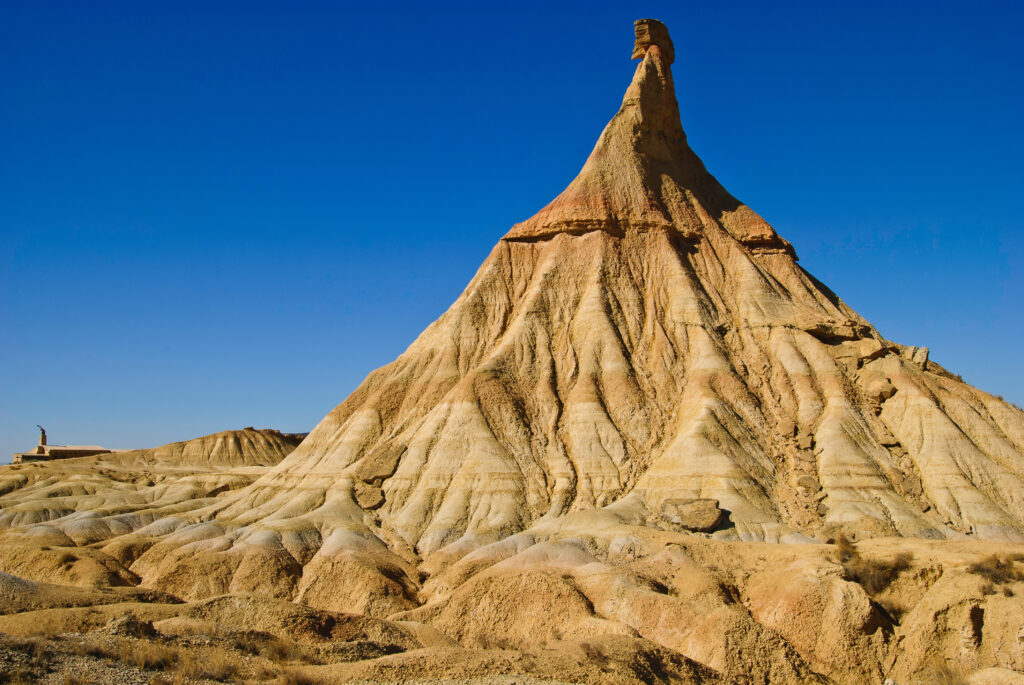
Nature has shaped bizarre landscapes in the south-east of Navarre. The Bardenas Reales World Biosphere Reserve will overwhelm you with its semi-arid landscape. This unique natural space, shaped by water, wind and sun, offers tranquillity and sporting opportunities.
The natural park is divided into two contrasting parts: Bardena Blanca and Bardena Negra. The lunar landscape of Bardena Blanca is characterized by gypsum and clay as well as deep ravines and mountains crowned by rocks called “cabezos”, such as Castildetierra, El Fraile or Las Cortinillas. In the greener part of Bardena Negra, Aleppo pines bear witness to the biodiversity of the region.
This unparalleled landscape can be discovered via the 700-kilometre network of hiking and cycling trails. If you’re in shape, you can enjoy the surroundings on the Gran Bardena hiking trail, which is almost 70 kilometers long. But there are also easier options such as the Landazuria cycle route through the Bardena Blanca, which is only 14 kilometers long.
Perhaps this will all look familiar to you. This may be because the Bardenas Reales have been the backdrop for several well-known film and television productions. Series such as Game of Thrones and films like The Counselor or The World Is Not Enough are partly set in this landscape. But don’t worry: you don’t need to fear dragons.
Ochagavía
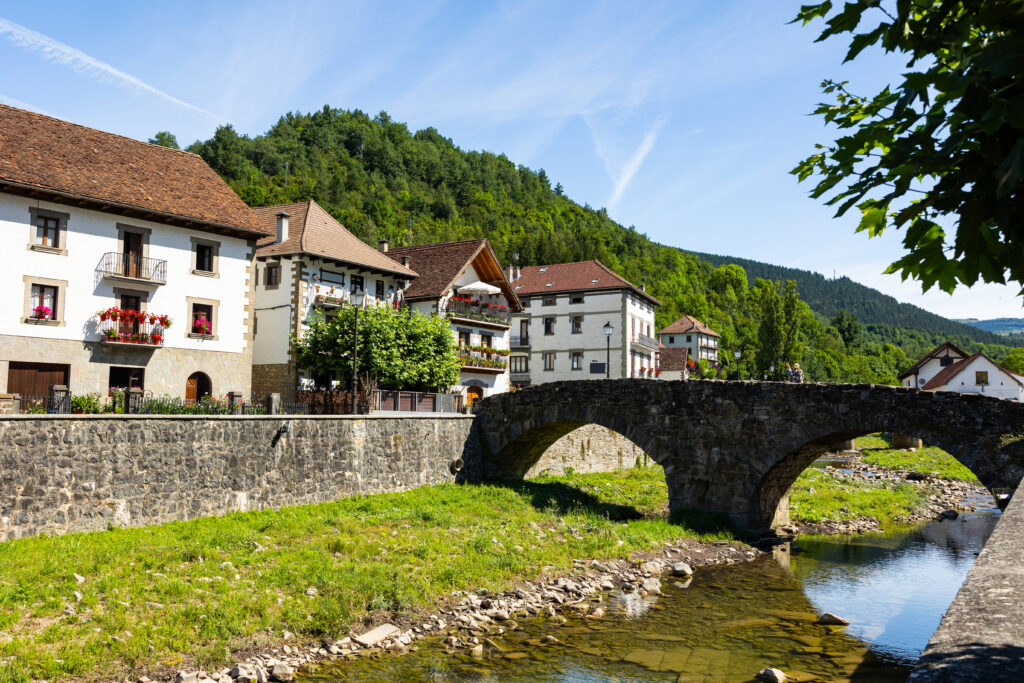
Ochagavía is a picturesque village in the region of Navarra, in the north of Spain. Its history dates back to the Middle Ages and has witnessed various events and changes over the centuries.
It is believed that the origins of Ochagavía date back to the 12th century, when the town became an important population center in the region. In the Middle Ages, the town was ruled by various noble families.
Even today, Ochagavía is still a popular tourist destination in Navarre. Its architecture, with its stone houses, cobbled streets and medieval bridges, gives it a unique charm. Its location in the Salazar Valley, surrounded by mountains and forests, also makes it an ideal place for outdoor activities such as hiking and cycling.
One of the highlights is the medieval stone bridge that was built over the River Anduña. This historic structure is still in perfect condition and bears witness to the technology and aesthetics of bygone eras.
The church of San Juan Evangelista is also a masterpiece of impressive architecture that combines elements from different eras. Its origins date back to the year 1200, and various modifications and additions were made during the sixteenth and seventeenth centuries. The interior of the church houses three Renaissance altarpieces of great artistic value, commissioned by Miguel de Espinal in 1574.
Irati Forest
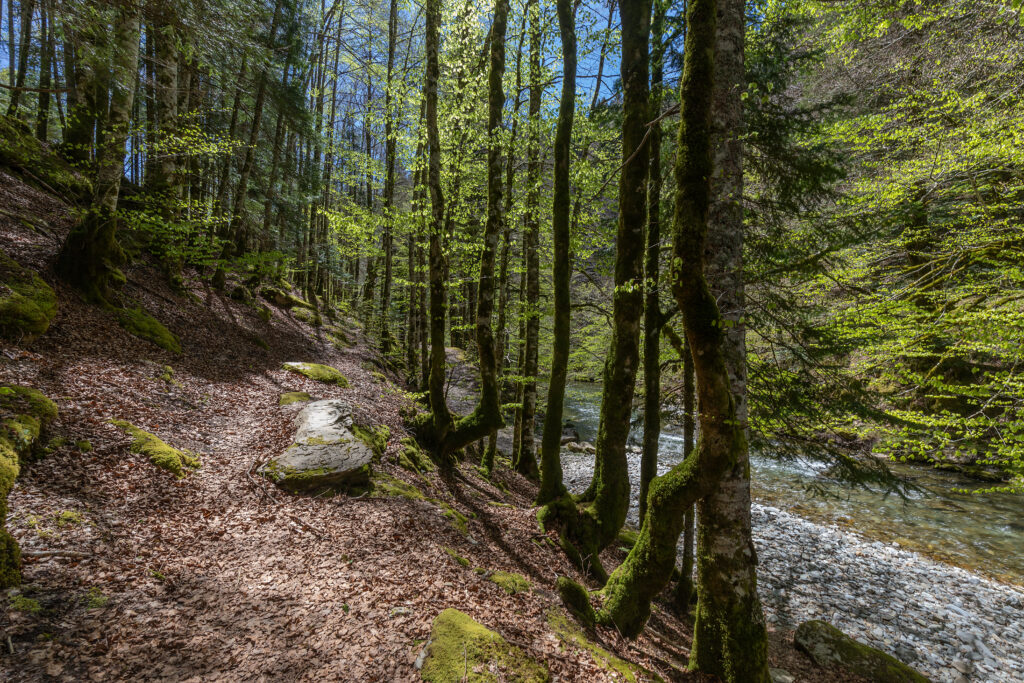
The Irati forest in the north of Navarre is a very special destination in the fall. With their red, yellow and green leaves, the beech trees transform the forests in the Pyrenees into a sea of color.
After the Black Forest, the Irati Forest is the largest forest area of beech and fir trees in Europe. The protected areas in the western Pyrenees in Navarre cover an area of 17,000 hectares. The forest area, which extends into France, is a UNESCO World Heritage Site.
The best time to visit is October. The autumnal foliage transforms the beech forests into a peaceful sea of flames. Mosses and lichens add the color green, and when the weather is fine, the sky turns blue. Equipped with hiking boots and a rain jacket, hiking trails of varying degrees of difficulty beckon.
The forest is home to many animals. Foxes, wild boars, squirrels and martens live in the mountainous region. There are also a wide variety of bird species. In the fall, during the rutting season of the deer, the roaring of the animals breaks the silence of the forest.
Valley of Baztan
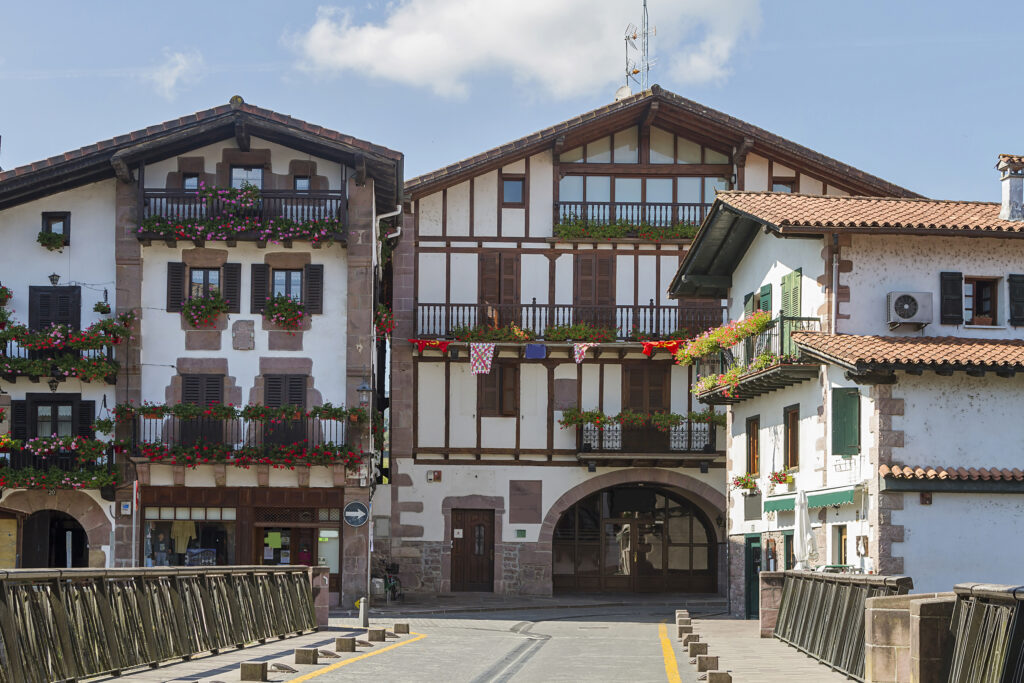
The rain-rich and therefore green valley is bordered by mountains that reach an altitude of over 1,400 meters in the south. It is named after the river Baztan, which changes its name later on and flows into the Bay of Biscay as the Bidasoa between the coastal towns of Hondarribia and Hendaye, forming the border between France and Spain.
The Valle de Baztan is characterized by green pastures and mountain slopes, interspersed with forests of beech, oak and chestnut trees. In terms of area, the towns in the Valle de Baztan form the largest group of municipalities in Navarre under the name of Baztan, with the seat of the municipality in the main town of Elizondo.
Basque is spoken predominantly in the valley and the old traditions are maintained, especially during the local festivals in summer between June and August.
The individual villages are characterized by their scenic location. Manor houses with towers, small baroque palaces and beautiful churches characterize the townscape. In between are detached farmhouses, with cows and horses grazing in the pastures.
Many of the houses are decorated with family coats of arms. At the end of the 14th century, the self-confident families of the valley ensured that all male inhabitants of the Baztan Valley were given the aristocratic title of Junker. Some of the old houses are now used as vacation homes or apartments. Rural tourism is now one of the most important sources of income alongside agriculture.
Tudela
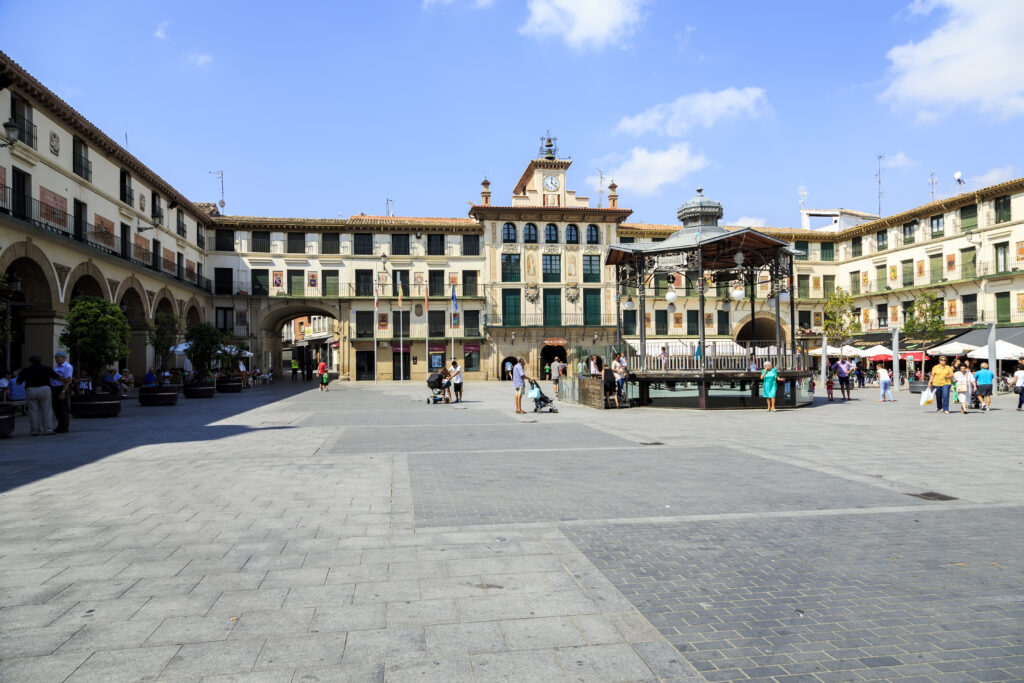
In 802, the Moors began fortifying the previously insignificant settlement. In 1119, King Alfonso I of Aragón brought the town under Christian rule. Tudela flourished in the following centuries. Christians, Jews and Moors lived together peacefully.
The Cathedral of Santa María de Tudela stands in the middle of the old town. Construction of the late Romanesque church began at the end of the 11th century on the site of the former mosque. Numerous motifs depict all variations of the unchaste life which, according to medieval moral concepts, led to eternal life in hell. The west portal with a depiction of the Last Judgement is well worth seeing. Storks fly around the cathedral tower, having built their nests at lofty heights.
The center of Tudela is the Plaza de los Fueros, surrounded by three-story houses with arcades. A pavilion stands in the middle of the square, with the Casa del Reloj at the front. The square dates back to 1687 and was also used as a bullring in earlier times.
The Mirador on the Cerro de Santa Bárbara in the north of the old town offers a beautiful panoramic view of Tudela and the surrounding area. The figure of Christ on the hill, visible from afar, serves as a guide. The view sweeps across the old town of Tudela to the green gardens on the banks of the River Ebro.
Estella-Lizarra
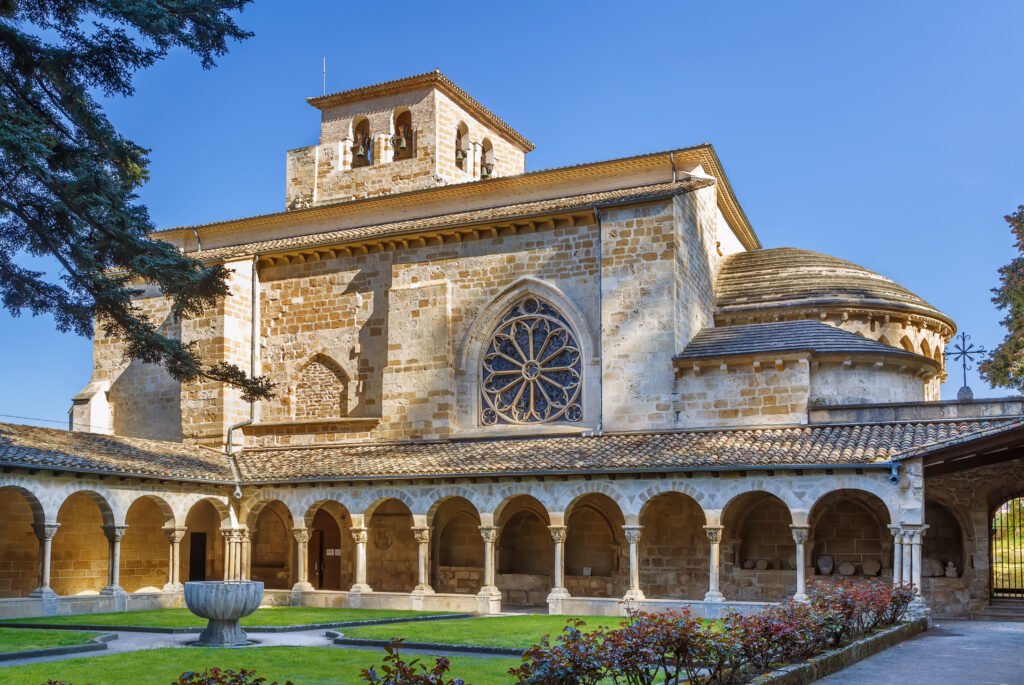
The Palace of the Kings of Navarre is located at the south-eastern entrance to the town. This was built in the second half of the 12th century and is considered the only preserved Romanesque secular building in Navarre.
Opposite the palace, a stone staircase leads up to the church of San Pedro de la Rúa, the construction of which began in the 12th century. The partially preserved Romanesque cloister is well worth seeing.
The way into the old town of Estella leads over a bridge that crosses the Río Ega. From here, the view to the right is of the river and the church of Santo Sepulcro. The path continues through Calle Mayor to the central Plaza de los Fueros square.
The church of San Miguel, whose main attraction is the north portal decorated with figures, is enthroned on a small hill. It is worth taking a stroll through the alleyways of the old town or stopping off at a restaurant. Local specialties include suckling pig and trout.
The history of Estella is closely linked to the Way of St. James. In 1090, Sancho Ramírez, King of Aragón and Pamplona, settled Frenchmen from southwest France in the almost deserted town. He also had the Way of St. James moved a few kilometers so that it ran directly through the town.
Pilgrims’ accommodation was set up in Estella. Craftsmen and traders settled here. The town thus became a busy and valued stop on the pilgrimage route, which was as important as Pamplona or Burgos in the 13th century.
Castle of Olite
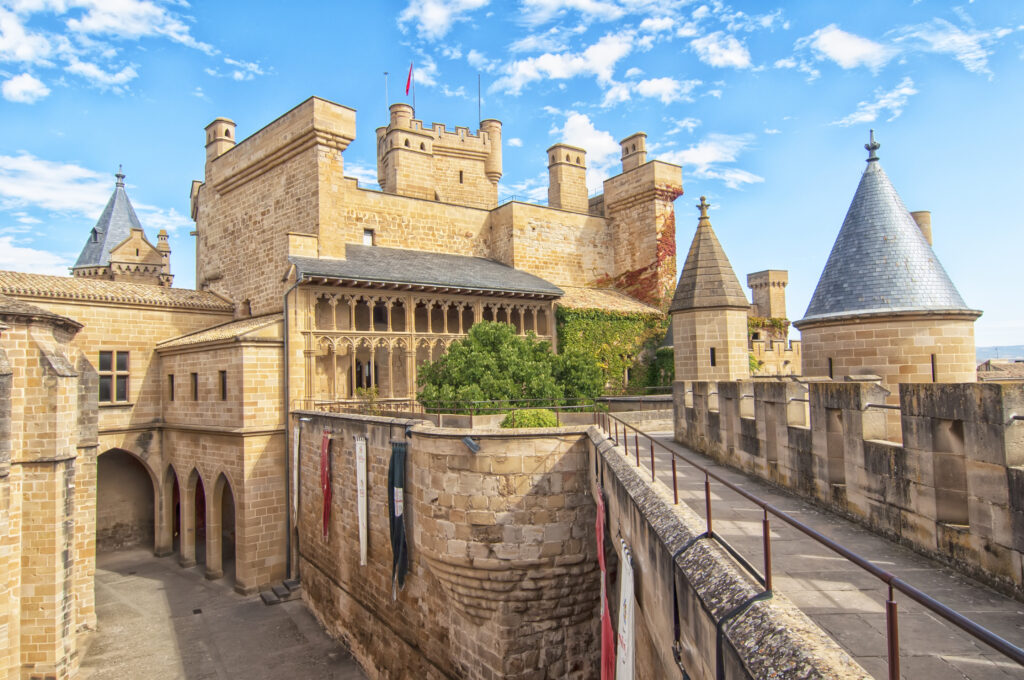
Located around 40 kilometers south of Pamplona, Olite was the seat of the kings of Navarre in the Middle Ages. At the beginning of the 15th century, Carlos III initiated the construction of a royal palace, the Palacio Real de Navarra de Olite.
The fortified residence is the main attraction of the town, which can of course also be visited. Part of the palace houses a Parador, a luxury hotel belonging to the state hotel chain.
Other sights include the churches Iglesia de San Pedro and Iglesia de Santa María La Real. The latter has a beautiful portal from the Renaissance period. We walk along the medieval alleyways past pretty Baroque and Renaissance palaces.
Behind the city gate begins the Rua Major, which runs right through the old town. The Plaza de los Teobaldos with the Parador, the Wine Museum and the Iglesia de Santa María La Real is just a few steps away. The entrance to the Royal Palace is on the right behind the church.
From here, Rua Villavieja leads to the oldest church in Olite, the Iglesia de San Pedro. In an arc to the right, small alleyways such as Rua Solana lead back to the main street, Rua Major. This leads in a northerly direction via the beautiful Plaza Carlos III El Noble back to the starting point. Along the way, there are many opportunities for shopping and visiting wine shops, bars and restaurants.
Cave of Zugarramurdi
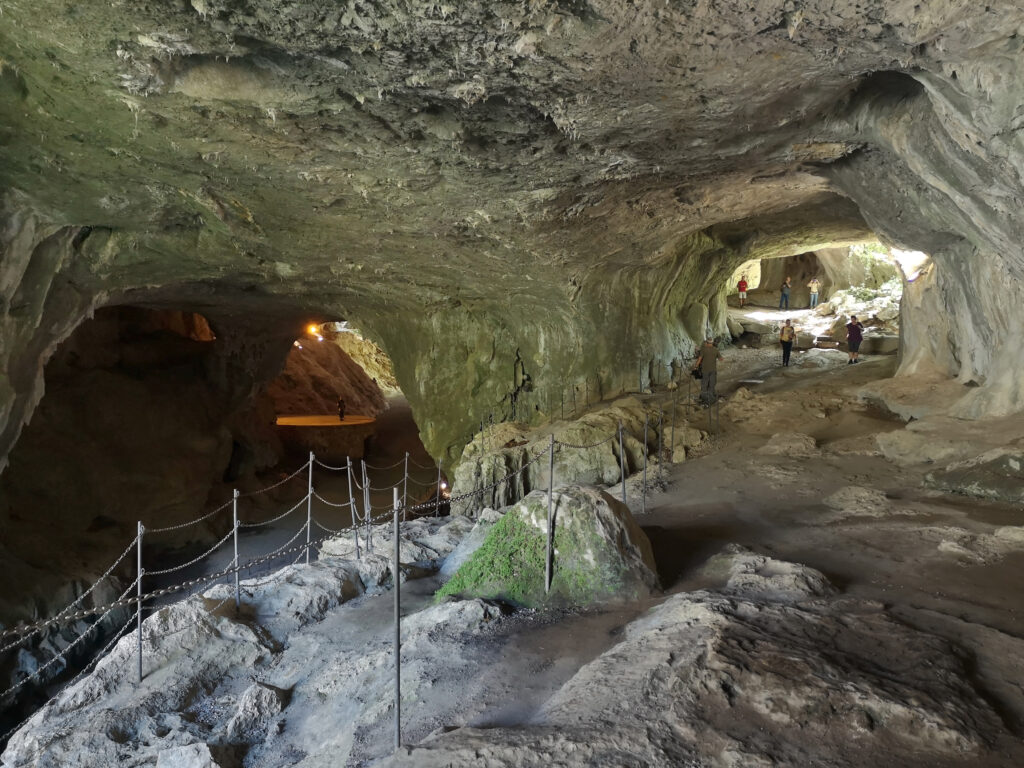
The village of Zugarramurdi is located in the very north of Navarre on the border with France. Surrounded by the foothills of the western Pyrenees, it offers a beautiful view of the Larrún mountain. Typical Basque-style houses characterize the town around the Iglesia de la Asunción church.
According to historical records, 53 people from Zugarramurdi were arrested and accused of witchcraft by the Inquisition. Most of them died before the trial began. In 1610, 11 “witches” were sentenced to death and burned at the stake in Logroño.
The museum “Las Brujas de Zugarramurdi”, which is housed in the former Casa Dutaria hospital, is dedicated to this historic event. The exhibition tells the story of the alleged witch María de Ximildegui, who publicly confessed to witchcraft in repentance. A second section deals with the spread of the belief in witchcraft in the Middle Ages.
A few steps behind the museum is the entrance to the witches’ cave “Las Cuevas de Zugarramurdi”. The Orabidea stream has dug the approximately 120-metre-long tunnel through the karst rock. This is where the witches are said to have met and celebrated the witches’ Sabbath. The “zikiro-yate” takes place in the cave every year. A culinary gathering of the locals where lamb is roasted on large barbecues. Of course, guests are also very welcome at this event.
Gorges of Lumbier and Arbaiun
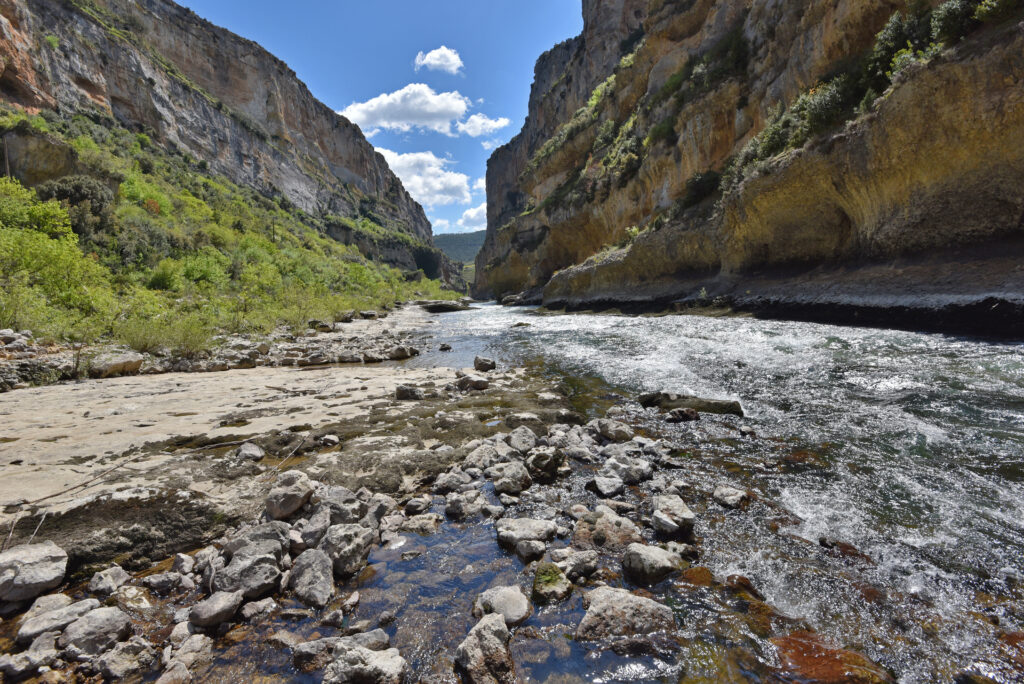
There are 2 beautiful gorges in the north of Navarre: The gorge of Arbayún and the gorge of Lumbier. The river Salazar rises from the Pyrenees and over millions of years has carved a mighty 5.6-kilometre-long gorge with dizzying walls over 300 meters high.
The gorge Arbayún is known as the queen of Navarre’s gorges, which is quite understandable given its mighty appearance. The gorge is only accessible to canoeists; otherwise it belongs to the vultures. You can see bearded vultures and griffon vultures as well as several species of falcon.
The river Irati has carved out the narrow gorge Lumbier and the cliffs here reach a height of 150 meters. The interesting thing about the gorge is its history, as the approximately 1,500-metre-long path through it is the former route of the Irati train; the first electric train in Spain, which connected the cities of Pamplona and Sangüesa between 1911 and 1955.
Some pylons and the two tunnels, which are now part of the hiking trail, have been preserved. The walls of the gorge are not as high as those of Foz de Arbayún, but are still very impressive. The best part was the numerous griffon vultures, either flying low in the gorge or perched on a rock in the walls. You are in a true bird paradise!
Urbasa Andía Natural Park
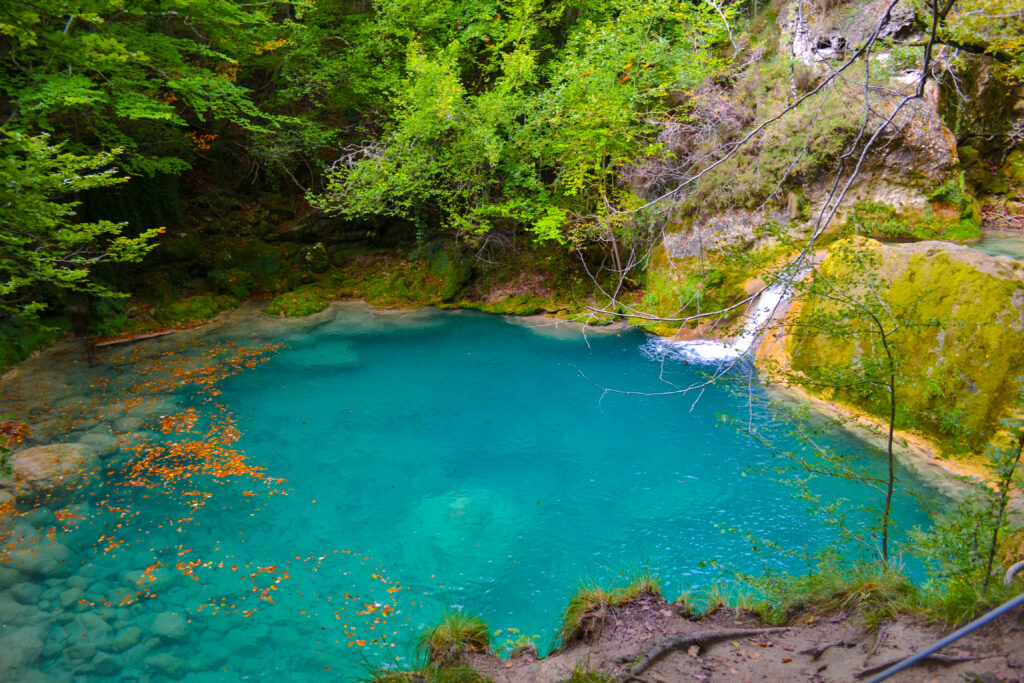
Urederra in Navarre is a natural spectacle: the little river springs from the karstic rock of the Urbasa plateau over a 200-metre drop. Urederra flows over various waterfalls towards Bakedano and Lizarra. it is an extremely fragile ecosystem, which is why access is limited to 500 visitors each day. The plateau itself also offers many interesting things: herds of animals, cheese and coal traditions, prehistory, hiking tours, tragic stories from the war.
Urederra means “beautiful water” in Basque, it is the name of a river that rises at the southern end of the Urbasa plateau and can be reached on a 4-hour hike.
Urbasa has been a protected nature park since 1997. The plateau covers an area of 21,000 hectares and is characterized by beech forests and pastures. The barely inhabited Urbasa is interesting in many respects: for its geological, biological, ecological, landscape, archaeological and historical references.
The plateau also represents the border between two bio-climatic zones, the Atlantic and the Mediterranean.
Orreaga/Roncesvalles
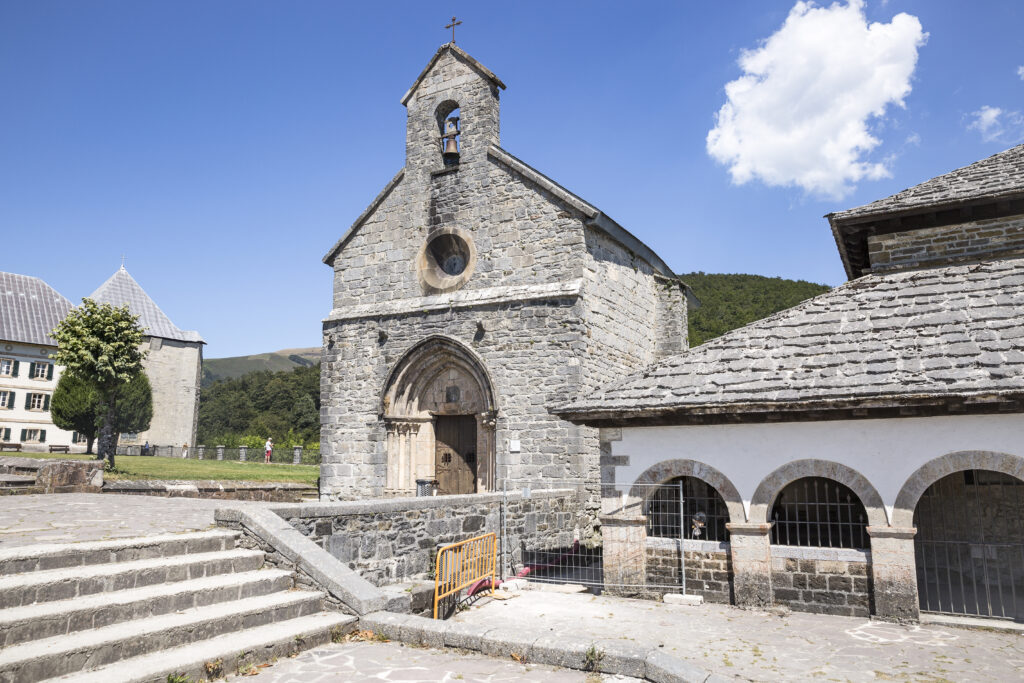
The village of Orreaga / Roncesvalles, as it is officially known in Basque or Spanish, lies at an altitude of 944 meters on the southern side of the Pyrenees at the foot of the 1,066-meter-high Ibañeta Pass.
Anyone who has made it this far in hiking boots from Saint-Jean-Pied-de-Port in France will have been on the road for around 8 hours and will be really exhausted after 24 kilometers of walking. The hike led over the 1,344-metre-high Col de Bentarte pass. For most pilgrims, this is the first stage on the Way of St. James.
The ridge of the Pyrenees is often shrouded in clouds and the wind can whistle quite violently up here, even in summer. This may be the reason why the historic pilgrims’ hostel in Roncesvalles was built in a sheltered location on the southern slope.
The village is dominated by the collegiate church Real Colegiata de Santa María and the Augustinian monastery. The church, built in the French Gothic style, was erected between 1215 and 1221 on the initiative of the King of Navarre, Sancho VII El Fuerte. His tomb can be seen in the chapter house.
After numerous fires, the church was renovated and remodeled at the beginning of the 17th century, adding Baroque elements mainly to the interior. The silver-plated statue of the Mother of God from the 14th century is the destination of pilgrimages on the last Sunday in April. In the museum, which is well worth a visit, you can see an alleged chessboard of Charlemagne.
Ujué
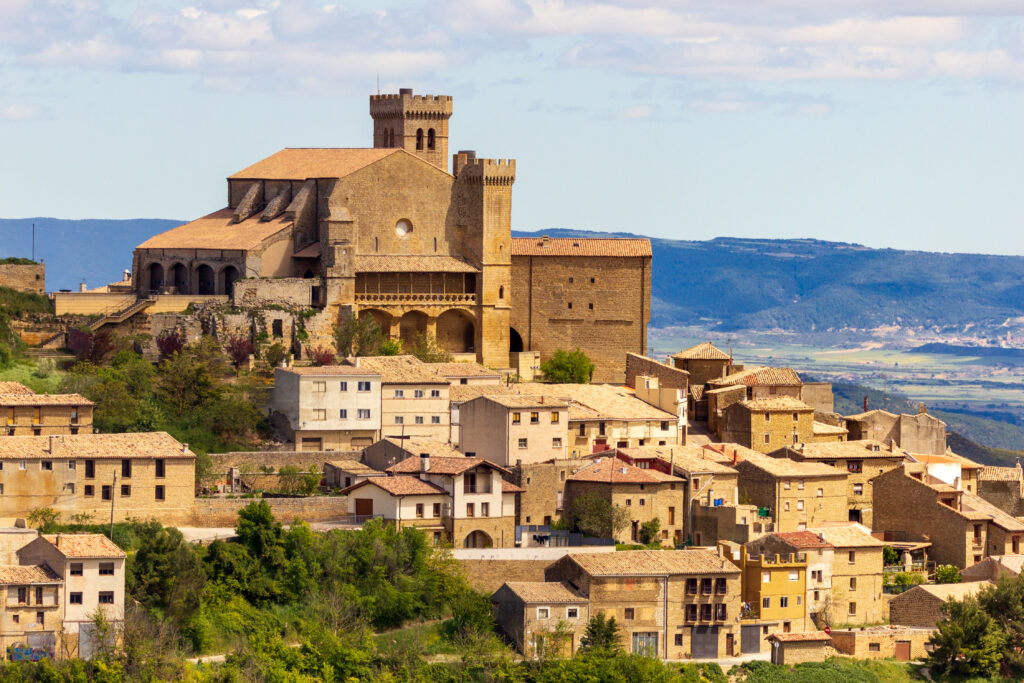
Ujué has seen better days. But it is well worth the trip to the old village, which is picturesquely situated on a mountain ridge. The massive Santa María church catches the eye as soon as you arrive. The village lies at an altitude of 815 meters within the hilly, southern foothills of the Pyrenees southwest of the town of Sangüesa. The village was already fortified in the Middle Ages and had a castle, on the site of which the fortified church can be found today.
Construction on the church of Santa María began in the 11th century. Fundamental reconstruction work, including the fortification walls, dates back to the 14th century. The Iglesia de Santa María features both Romanesque and Gothic style elements. The interior features a Romanesque statue of the highly venerated Virgen de Ujué. Two crenellated towers have been preserved: The Torre de los Cuatro Vientos and the Torre de los Picos.
The few alleyways in the historic village center are cobbled and the houses huddle around the church. The municipality suffers greatly from rural exodus.
From Ujué, there is a beautiful view to the south down to the Ribera de Navarra, the wide valley of the River Ebro. In between are mountains on whose slopes wine is grown. The town is a stop on the Ruta del Vino, which leads through the wine-growing regions of Navarre.
The town is known for its traditional processions. The Romería de Ujué takes place on the first Sunday after April 25. Barefoot and clad in a tunic, pilgrims carry heavy wooden crosses up the church hill.
Sangüesa
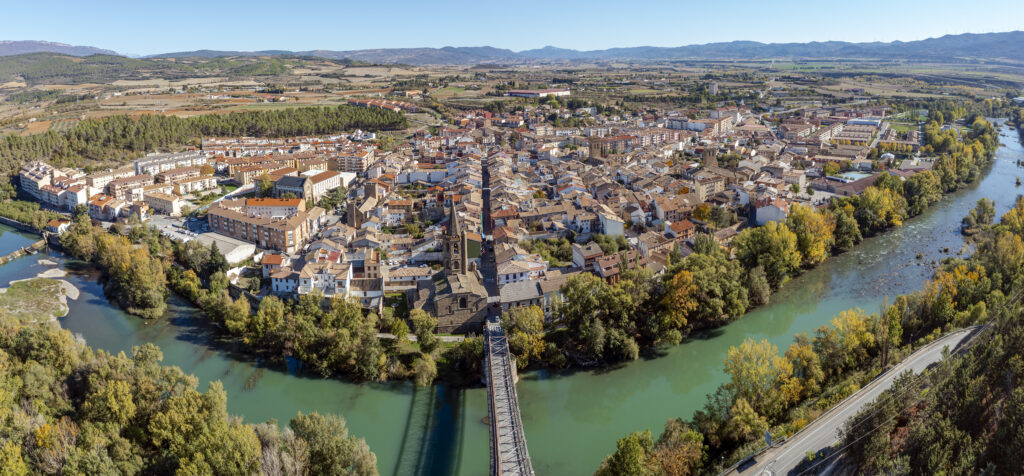
The picturesque town of Sangüesa on the banks of the Aragón is an important stop on the Way of St. James and is known for its architectural gems. One of the most outstanding buildings is the church of Santa Maria la Real. The south portal of the church is particularly impressive and is considered a Romanesque masterpiece due to its magnificent sculptural decoration.
The detailed stone carvings and ornate decorations make the portal a fascinating sight. The church of Santiago Apóstol from the 12th/13th century is further evidence of the town’s rich religious history and impresses with its Gothic architecture and ornate details. The monastery of San Francisco de Asis blends harmoniously into the historic cityscape.
The numerous aristocratic palaces, which once belonged to the wealthy families of the region, bear witness to the town’s magnificent past. The well-preserved buildings and impressive facades offer an insight into the way of life of the aristocratic families and the architecture of past centuries.
The historic old town of Sangüesa invites you to take a stroll and explore the narrow streets, charming squares and well-preserved historic buildings. The town palace stands out for its impressive architecture and rich history.
El Cerco de Artajona
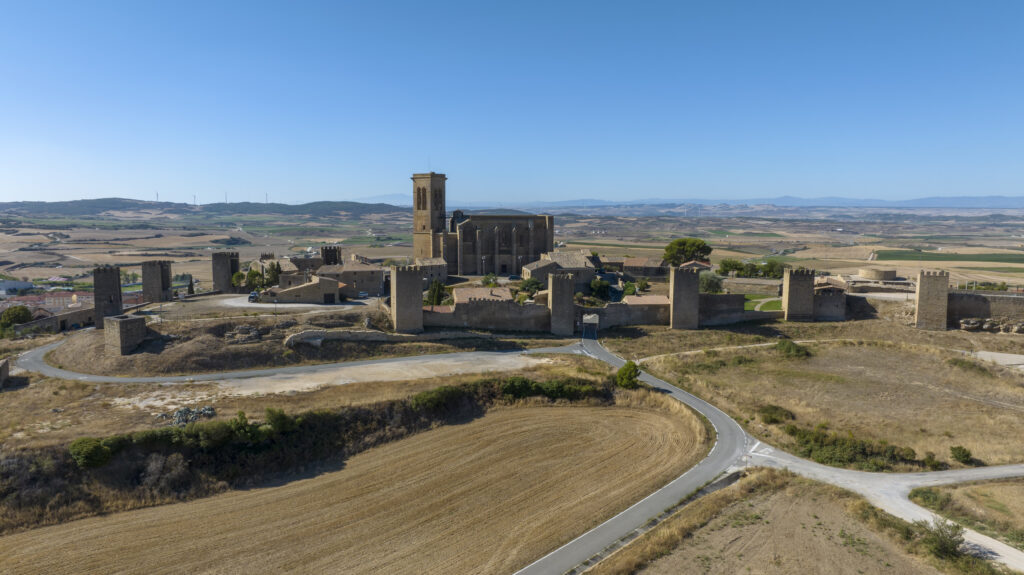
Artajona is one of the best-preserved walled towns in all of Navarra. The profile of its walks and its battlements is representative of its rich artistic patrimony, which extends to its medieval town. It has cobbled streets filled with stately buildings that rise as high as their defensive walls (El Cerco) allow.
Built in 1805 (although the current set was built earlier, probably in the 13th or 14th centuries), El Cero shelters the first city of the 11th century. It included nine battlements, in perfect condition, and two doors through which you can enter, also from medieval times. There exists in Artajona a legend that claims wine was used in its construction instead of water.
San Saturnino Church is another structure that forms part of Artajona’s skyline. Its building was erected in the 13th century over the site of a former Romanesque temple, and it was built to be a fortress; there was a prison in its towers, and you had to cross a drawbridge to get to its highest parts.
Its western side is the only one that does not comply with the defensive style. Distinguished by its arched entrance and the gallery that is arranged on both sides, initially designed to contain images of the apostles. The painted Gothic walls that are preserved inside are also particularly interesting.
Castle of Xavier
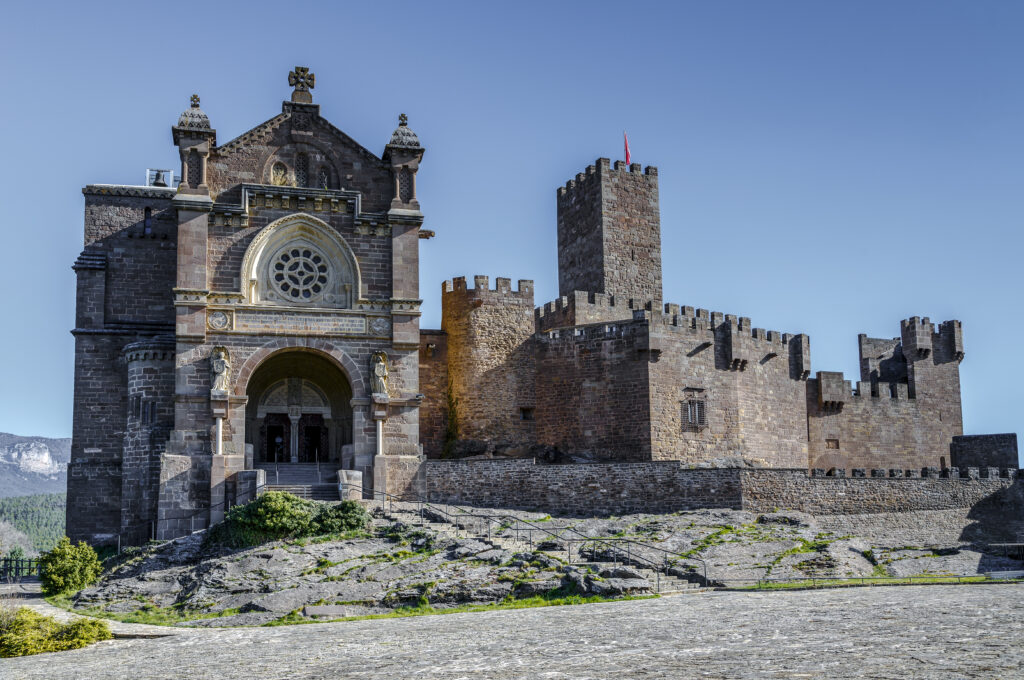
The town’s main attraction is the well-restored castle, the Castillo de Javier. Francisco de Xavier was born in this historic building on 3.12.1552, who is known as Franz Xaver in German.
The name of the castle has its origins in Basque and translates roughly as “new house”. The beginnings of the fortification go back to a watchtower, which was intended to secure the border to the Moorish-ruled areas. The border station was gradually extended and enlarged.
In 1516, the Grand Chancellor of Castile, Jiménez de Cisneros, ordered the castle to be destroyed as the local nobility resisted the annexation of Navarre by Castile. As a result, the castle fell into ruins. Restoration work then began at the end of the 19th century. Today, the spruced-up Castillo de Javier presents itself as a typical Spanish castle with battlements and towers.
The San Miguel keep is the oldest part of the fortress. Worth seeing is the Capilla del Cristo with a late Gothic figure of Christ and a series of murals depicting death. At the beginning of the 20th century, the castle, including the basilica, was transferred to the Jesuits. The order runs a spiritual center here and maintains the castle museum.
Yesa
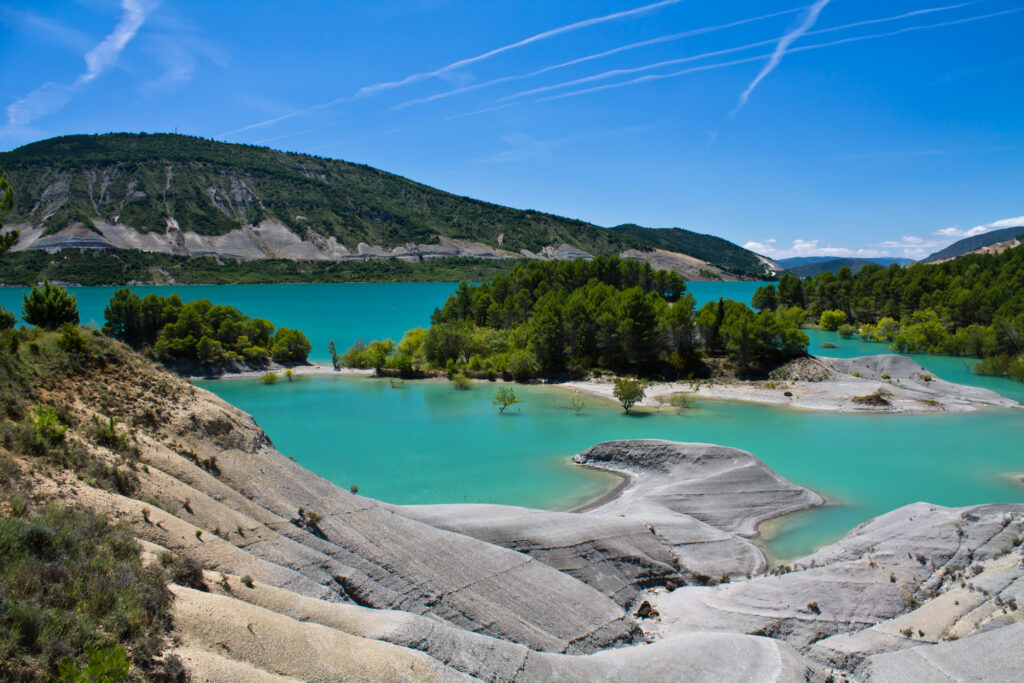
At the foot of the mountain ridge of the Sierra de Leyre lies the small village of Yesa. This charming village impresses with its picturesque location and impressive sights. Of particular note is the Yesa reservoir, which is also known by many as the ‘Sea of the Pyrenees’.
The reservoir is the largest navigable area in Navarre and offers numerous opportunities for water sports and recreation. The breathtaking scenery of the reservoir, surrounded by majestic mountains and lush nature, makes Yesa a popular destination for nature lovers. Leyre Monastery, which was consecrated in 1057, had a major influence on monastic architecture in Spain. The monastery impresses with its historical significance and magnificent architecture.
It is located in the middle of a spectacular landscape that includes the Yesa reservoir, mighty mountains and the nearby Sierra de Erraonso. The monastery of Leyre is an important example of Romanesque architecture and is home to numerous works of art and relics that reflect the rich history and culture of the region. Visitors can tour the impressive church, the crypt and the beautiful cloister, all of which are masterfully designed.
Yesa itself offers an idyllic setting for walks and exploration. The proximity to nature and the impressive sights make the village an ideal starting point for hikes in the surrounding mountains and for excursions to the reservoir.
Viana
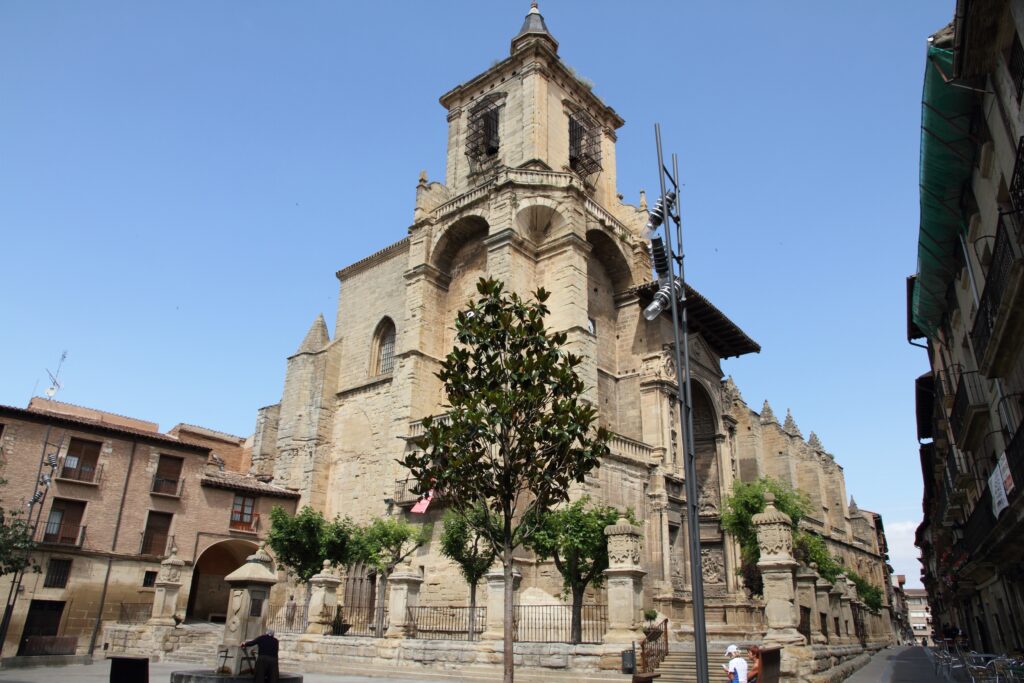
The medieval town of Viana on the Way of St. James was founded in 1219. People are said to have lived on the site of today’s town as early as the Palaeolithic Age. The entire old town of Viana is considered a historically and artistically valuable ensemble.
Buildings worth seeing include the town hall, built in the 17th century in various architectural styles, which adorns the center of the city with its impressive façade. The Plaza Mayor, the town’s main square, is surrounded by historic buildings that reflect Viana’s rich history and cultural significance.
The Gothic church of Santa Maria impresses with its ornate decorations and majestic interior. The richly decorated altars and impressive stained glass windows make it an outstanding example of Gothic architecture in the region.
The ruins of the church of San Pedro, a Cistercian church from the 13th century, cannot be overlooked. Despite its ruinous state, the impressive apse and the 18th century portal zone bear witness to the former splendor of this holy site. The ruins offer a fascinating insight into the medieval architecture and religious history of Viana.
Monastery of Leyre
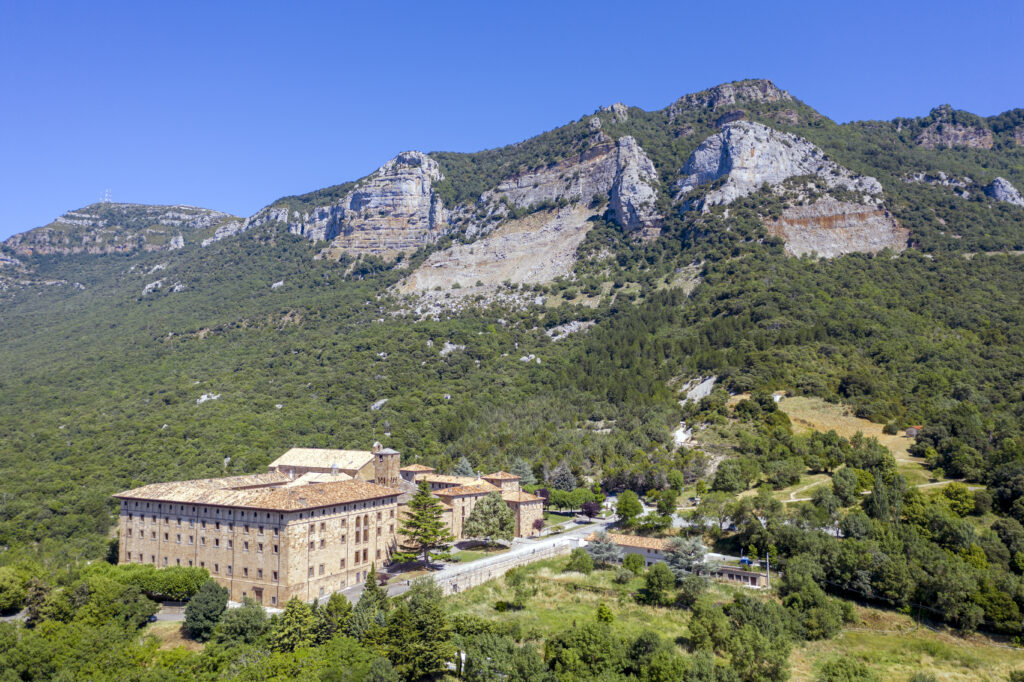
The monastery complex is one of the oldest and most important religious buildings in Navarre. However, the exact date of foundation of the monastery is unknown. However, the first evidence dates back to the 9th century.
The monastery was built by the Benedictines and later taken over by the Cistercians until their expropriation in 1836. After the conquest of Pamplona by the Moors in 860, the bishop’s seat was moved here.
The first kings of Pamplona, whose domain was later absorbed into the Kingdom of Navarre, were buried here. The crypt under the Romanesque church of San Salvador de Leyre, which was consecrated in the 11th century, served as a burial place. The tombs of the kings are now located in a side chapel.
The late Romanesque west portal of the church, the Porta Speciosa, is well worth seeing. The Savior (Salvador) is depicted in the middle of the tympanum. The church’s landmark is the ensemble of the simple square tower and the apse of the monastery church. Inside the church, a statue of Santa María de Leyre stands on a column above the crucified Christ. The main altar dates from the 17th century.
The other monastery buildings date mainly from the 17th and 18th centuries. Today they house a hotel and a restaurant. Benedictine monks have been living here again since 1954.
Puente la Reina
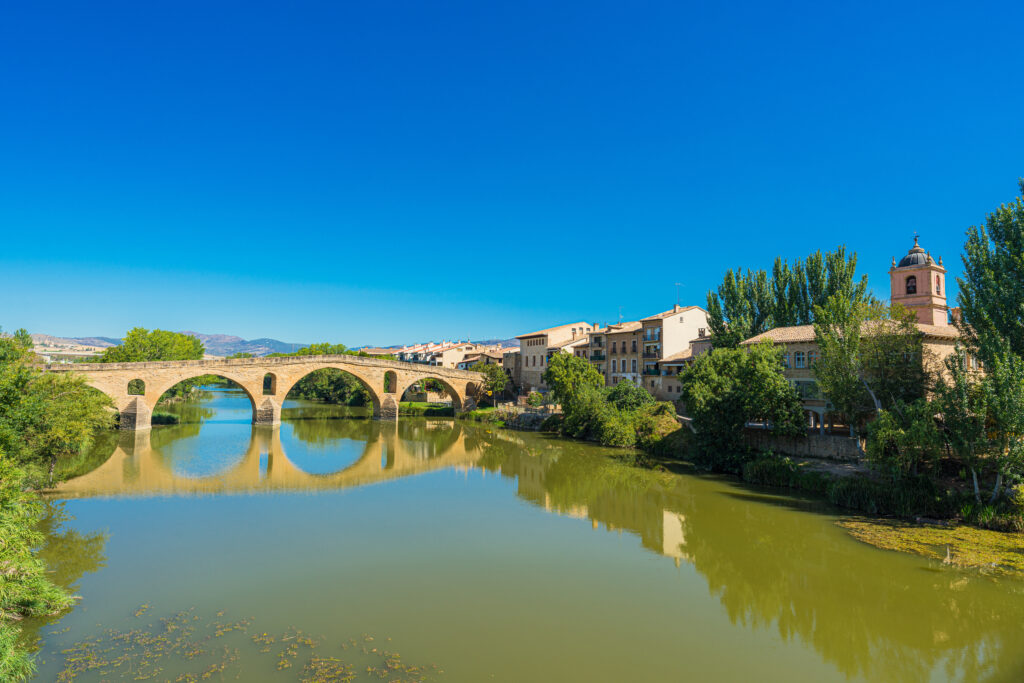
The Romanesque bridge over the River Arga was donated in the 11th century by Queen Doña Mayor, the wife of the King of Pamplona, Sancho el Mayor. Puente la Reina is where the two variants of the French Way of St. James to Santiago de Compostela meet.
The picturesque little town has barely 3,000 inhabitants. Despite this small population, Puente la Reina has three relatively large churches and numerous noble houses adorned with coats of arms. These are mainly located on Calle Mayor, the main street through the old town, which is also the route of the Camino de Santiago.
Along the Calle Mayor are beautiful aristocratic and bourgeois houses in the typical Navarre architectural style. The street leads directly to the Romanesque Puente la Reina bridge, which crosses the River Arga in seven arches over a length of 110 meters. Some say it is one of the most beautiful bridges in Spain. In any case, you can feel the centuries-old tradition of pilgrimage on the Way of St. James as you cross this structure.
When the region was conquered by the Moors at the end of the 9th century, Alfonso I, King of Aragón, brought French settlers to the deserted and insecure area. The town was systematically developed and fortified, with similarities to the bastides in the southwest of France.
The construction of the bridge over the River Arga boosted the town’s economy. The pilgrims brought money into the town and pilgrims’ accommodation was set up.
Isaba
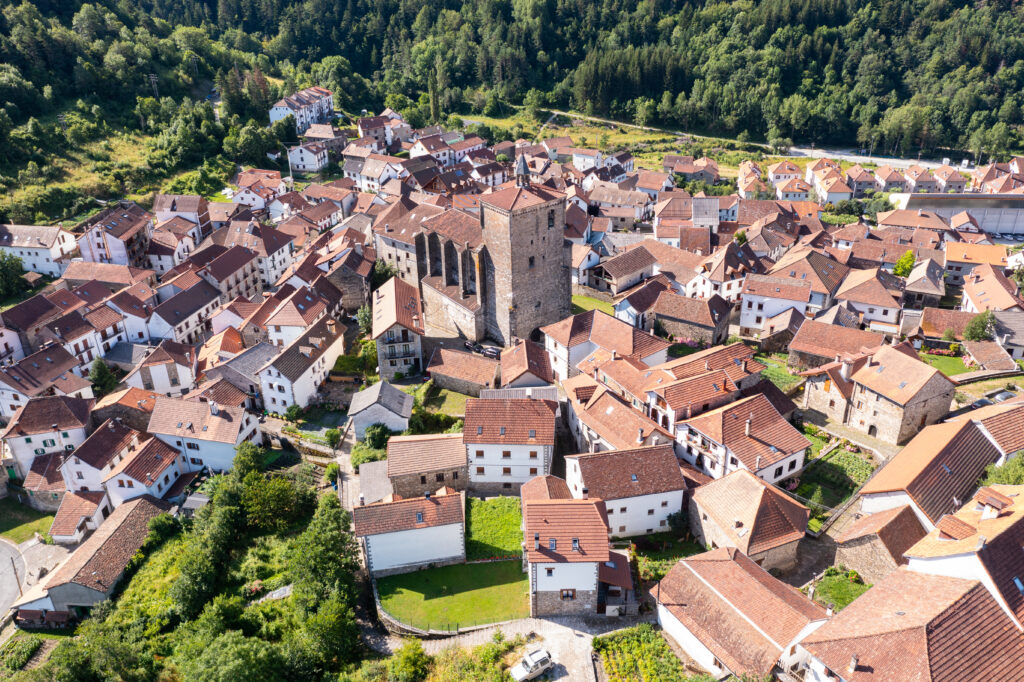
The small town of Isaba is the northernmost village in the scenic Valle del Roncal valley in the Navarre Pyrenees.
The village is a good starting point for hikes and excursions in the Pyrenees, mountain bike tours in summer and cross-country skiing in winter.
The small settlement shows the typical architecture of a farming village in the Pyrenees region of Navarre.
The square tower of the San Cipriano church towers over the village, imposing and fortified. The church was built in the 15th century. The main altar in Plateresque style is worth seeing. The baroque organ dates back to 1751.
The narrow streets are paved with stone. Old stone houses with beautiful wooden balconies are decorated with geraniums.
The Valle del Roncal is a popular area for cross-country skiing in winter. In the north, the NA-137 leads through the Belagua Valley (Valle de Belagua) and the nature reserve La Reserva de Larra up to the Col de la Pierre St. Martín pass, where the border with France is reached at an altitude of 1,760 meters.
Gorges and caves characterize the wild landscape. The Mesa de los Tres Reyes (2,442 m) is the highest peak in the Navarre Pyrenees.
The Roncal Valley stretches along the River Esca from the heights of the Pyrenees down to the Voz de Burgui gorge. To the south of Isaba lies the even smaller village of Roncal. It is famous for its typical sheep’s cheese.
Pamplona
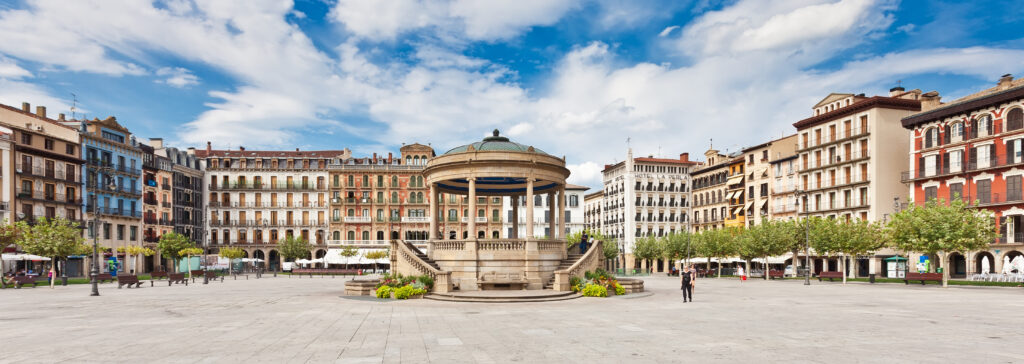
Pamplona is the capital of the province of Navarre and was the capital of the former kingdom of Navarre. The city is located roughly in the geographical center of the province, with the old town on a hill. The river Arga runs below it. The city was named after the Roman general Pompey, who settled in Pamplona.
Pamplona is the first city on the Way of St. James from France. The Jacobean route passes through the oldest part of the city, the historic center, and offers a good opportunity to lose yourself in its winding medieval streets.
Pamplona is one of the greenest cities in Spain, and the urban landscape cannot be understood without its parks and gardens, which oxygenate the city thanks to their lush vegetation and welcome walkers seeking peace and quiet on their way. Over 20% of the city is green and pedestrian-friendly, making it a privileged place for walks.
The city is one of the best-preserved Renaissance walled centers in Europe. The walled enclosure stretches for more than 5 km and allows you to experience and discover the history of the city.
The Bull Run and the “Sanfermines” are a world-famous popular festival that takes place from July 6 to 14. During the rest of the year, visitors have the opportunity to discover and experience these emblematic streets and squares.

